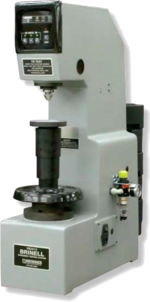Hardness
From DT Online

Hardness is a material's resistance to abrasions, surface scratching or indentation. It is a measure of wear resistance.
Several testing procedures have been devised to obtain a measure of Hardnesss and tables are available which compare results:
Brinell scale

The Brinell hardness testing procedure was the the first to be widely used and is carried out by applying a specific load to press a hardened steel ball of 1, 2, 5, or 10mm diameter into the surface of the materials for 10-15 seconds.
The Brinell Hardness Number is give by dividing the load applied (kg) by the area (mm2) of the circular indentation which results.
This method of testing is good for castings or other surfaces which are not very smooth because a more easily seen, sizeable impression can be made when using using the larger diameter balls. Because of this however, its disadvantage is that it does damage the sample under test.

Vickers hardness test
Vickers hardness testing applies a variable load to a pyramid shaped Diamond indenter for 15 seconds and the size of the resulting indentation is then measured with a microscope. The surface must first be polished so that such small impressions can be seen.
The Vickers Pyramid Number is calculated as for the Brinell Hardness Number. It is a more accurate testing method and can used on most materials because of its Diamond indenter.
Rockwell scale
Rockwell testing can use either a steel ball or a diamond cone indenter. A small start load is applied then increased and finally returned to the start load and the depth of impression is read directly off a Dial Gauge type scale.

Scaling factors enable a hardness value to be read directly making this the fastest method and therefore very popular for routine hardness testing of mass-produced components.
Note:
Both Vickers and Rockwell testing can be used on Ceramics but less surface damage is caused if a process known as Knoop testing is used. This method is also used for thin sheet materials, where only a small indentation may be made for testing purposes.

Janka hardness test
The Janka test is similar to others but is used to measure the hardness of wood. An 11.28mm diameter steel ball is pressed into the surface to half its diameter and the force required to do this measured.